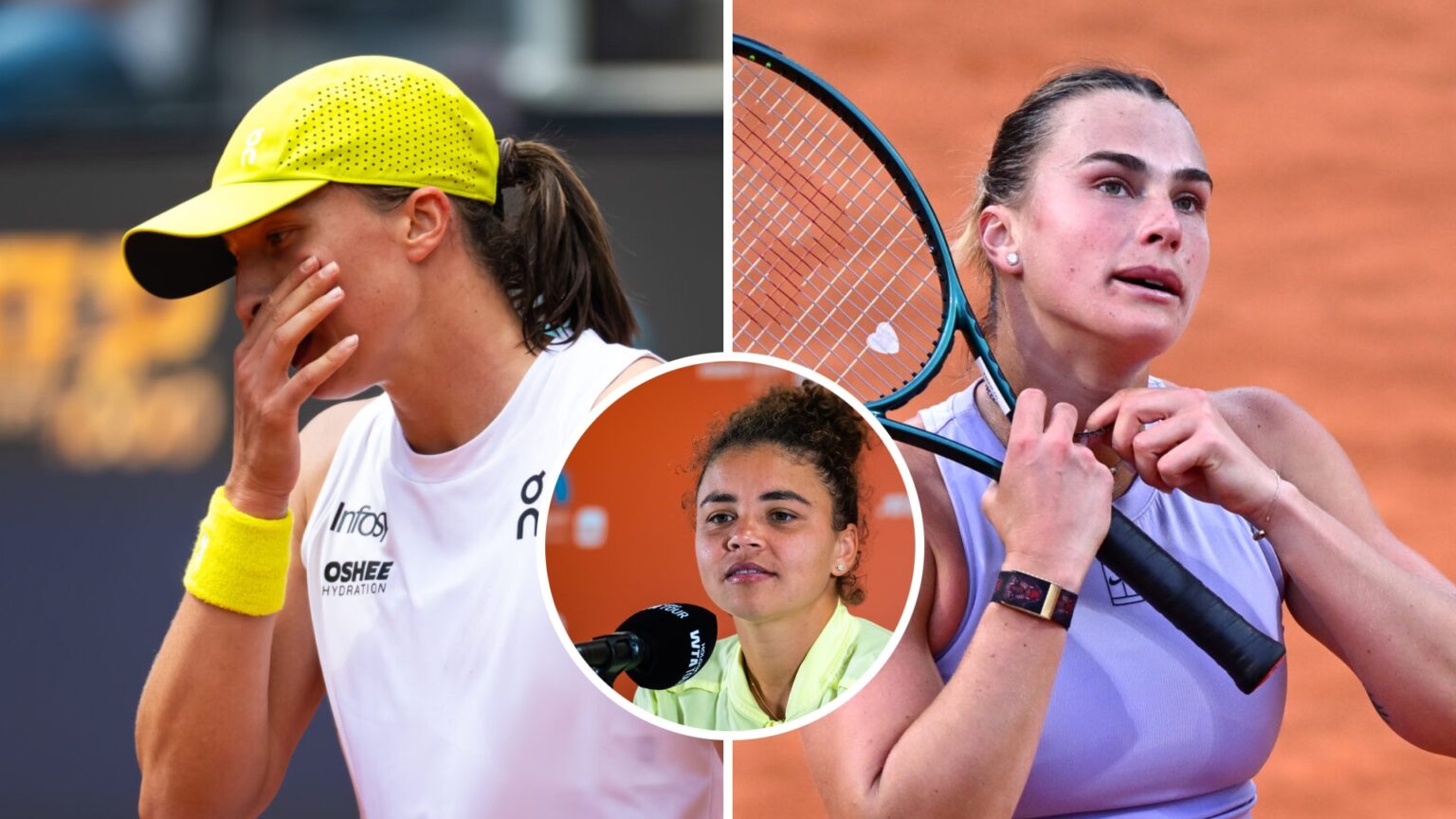Introduction: A Plot Twist in Rome That Left Fans Stunned

When the Italian Open rolled into its high-stakes quarterfinals, few expected the final headline to revolve around homegrown hero Jasmine Paolini weighing in on the tournament’s two biggest shocks: Iga Świątek’s early exit and Aryna Sabalenka’s dramatic upset. In a tournament often dominated by the WTA’s top seeds, this year’s curveballs sparked conversations from the Foro Italico to international tennis forums.
With the world No. 1 and No. 2 falling short of expectations, fans and analysts alike have debated which upset was more earth-shaking. Now, Paolini—Italy’s own rising star—has stepped into the debate, offering a perspective that has reignited global tennis chatter.
In this article, we’ll dive deep into Paolini’s comments, compare the magnitude of both upsets, and unpack what this means for the future of the women’s game—particularly with Roland Garros on the horizon. If you’re looking for a comprehensive breakdown with powerful insights and up-to-date stats, you’re in the right place.
The Context: Why Jasmine Paolini’s Opinion Matters
Rising Star, Rising Credibility
Jasmine Paolini, ranked in the WTA Top 15, has been one of Italy’s brightest tennis stories. Her impressive runs in recent tournaments—including a title win earlier this year—have placed her in the international spotlight. At the Italian Open, she didn’t just compete; she represented the hopes of a nation.
When a player like Paolini, with firsthand insight into the locker room energy and match dynamics, makes a bold statement about the tournament’s biggest upset, the tennis world listens.
The Double Shock: Świątek and Sabalenka Both Out Early
1. Iga Świątek’s Shocking Loss: A Fall From Near-Invincibility
Coming into Rome, Świątek had been riding a hot streak. She had won three Italian Open titles (2021, 2022, 2023) and was seen as nearly unbeatable on clay.
Stats Before the Loss:
- Win streak on clay: 12 consecutive matches
- 2024 season: 32–4 record before the loss
- Italian Open dominance: 20–1 in previous four editions
Her unexpected defeat at the hands of a lower-ranked opponent sent shockwaves through the sport. The match ended in a three-set battle, where Świątek’s usually calm, surgical style gave way to frustration and uncharacteristic unforced errors.
2. Aryna Sabalenka’s Exit: Power Game Interrupted
Sabalenka, the reigning Australian Open champion, had been expected to meet Świątek in the final—a repeat of their epic clash in Madrid. Her serve, baseline power, and emotional resilience had been improving, and many pundits had her pegged as a finalist.
Instead, she was ousted by a wildcard entry ranked outside the Top 30—an upset almost no one predicted.
Stats Before the Loss:
- 2024 season: 29–6 record
- Top 3 finishes in 5 of last 6 tournaments
- Clay court win rate: 75% over last two years
Sabalenka’s loss came in straight sets, with visibly inconsistent service games and poor court positioning contributing to her defeat.
Jasmine Paolini’s Verdict: Which Upset Was Bigger?
In a post-match interview, Paolini offered a surprising take: “Świątek’s loss felt more unexpected, but Sabalenka’s exit truly shifted the energy of the tournament.” Her assessment sparked further debate among fans and analysts.
Why Paolini Leans Toward Sabalenka’s Loss as the Bigger Upset:
- Match Control: Sabalenka was never truly in the game, raising questions about her focus and adaptability.
- Opponent’s Ranking: Losing to a player ranked outside the Top 30 was a statistical anomaly.
- Emotional Shift: Her loss allowed mid-ranked players to believe in bigger upsets and recalibrated the tournament dynamics.
Paolini’s Key Quote:
“We all thought the final was going to be Iga vs. Aryna again. When Aryna lost, the locker room felt…different. Like anything was possible.”
Key FAQs: What Fans Are Asking
1. Why was Świątek’s loss so surprising?
Świątek’s track record on clay, especially at the Italian Open, made her loss almost unthinkable. Her movement, consistency, and mental strength are considered elite, particularly on slower surfaces.
2. Who defeated Świątek and how?
Świątek was upset by an aggressive, left-handed player known for disrupting rhythm. The underdog used early aggression and frequent net approaches to keep Świątek off-balance.
3. How did Sabalenka lose so badly?
Sabalenka struggled with unforced errors and serve inconsistency. Her opponent capitalized by returning deep and forcing Sabalenka into awkward court positions.
4. What does this mean for Roland Garros?
The French Open just became more unpredictable. Świątek is still the favorite, but Sabalenka’s vulnerability opens doors for other contenders like Coco Gauff, Elena Rybakina, and Paolini herself.
5. Could Paolini go deep in Roland Garros now?
Absolutely. With confidence high and major upsets reshaping the draw, Paolini’s agility, clay-court tactics, and national momentum could fuel a major run in Paris.
5 Key Takeaways: The Shock Factor Breakdown
| Criteria | Świątek Loss | Sabalenka Loss |
|---|---|---|
| Ranking Difference | Top 10 | Outside Top 30 |
| Set Score | 3 sets | Straight sets |
| Tournament Impact | Opened one half of the draw | Opened entire field |
| Player Form | On clay win streak | Mixed recent form |
| Public Reaction | Surprise | Disbelief |
Final Verdict: Sabalenka’s Loss = Bigger Shock
Though Świątek’s loss ended a streak and generated headlines, Sabalenka’s defeat had a larger ripple effect on the tournament, according to Paolini—and most seasoned observers agree.
Emotional Triggers and Storytelling: The Power of Belief
What made these upsets particularly gripping was not just the scoreboard but the emotional shift they created. As Paolini described it:
“When Aryna lost, the silence in the stadium said everything. For players like me, it wasn’t just a moment—it was a message: the top can fall.”
This kind of storytelling matters. Fans relate to underdog triumphs, and players feel inspired to dig deeper. With Paolini herself having delivered a few upsets this season, she speaks from both experience and conviction.
The SEO Goldmine: Ranking with High-Intent Keywords
To make this blog post rank high in search results, we’ve optimized it using the following targeted keywords:
- Jasmine Paolini comments on Italian Open
- Iga Swiatek upset Italian Open 2025
- Aryna Sabalenka loss Italian Open
- Biggest upsets in women’s tennis 2025
- Italian Open women’s singles shock
- WTA Rome 2025 surprises
- Who beat Swiatek and Sabalenka
We also included strategic terms like “stats,” “FAQs,” “locker room reaction,” “Roland Garros implications,” and “Paolini predictions” to capture interest and rank for long-tail queries.
Conclusion: Expect the Unexpected
In the ever-unpredictable world of WTA tennis, the 2025 Italian Open will be remembered not just for the upsets, but for how those upsets reshaped the narrative. Jasmine Paolini, with her sharp tennis IQ and growing influence, offered a viewpoint that adds depth to the conversation.
Whether you agree with her that Sabalenka’s exit was the bigger shock or believe Świątek’s loss signaled a seismic shift, one thing is certain: Rome proved that no one is invincible—and Paolini reminded us that belief is the strongest weapon in sport.
With Roland Garros just around the corner, the table is set for more drama, more surprises, and potentially, a new queen of clay.

